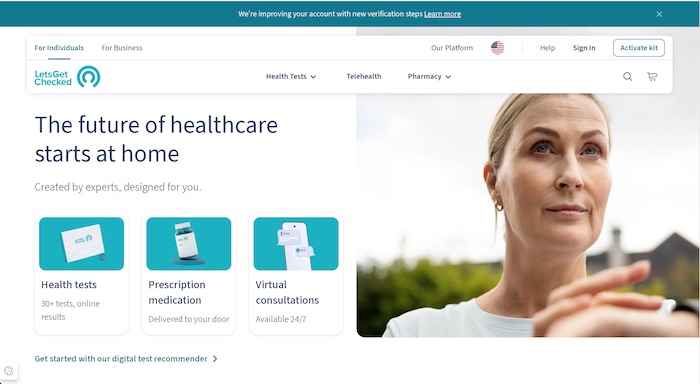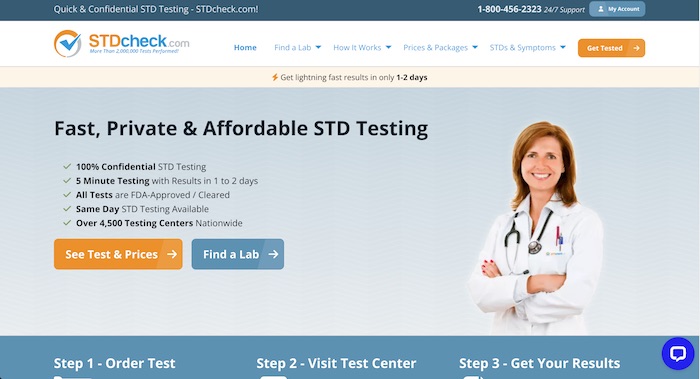
Sexual health remains one of the cornerstones of overall wellness, yet many people continue to avoid or delay testing for sexually transmitted diseases (STDs) out of embarrassment, fear, or misconceptions about the testing process. The anxiety often stems from long-standing cultural taboos around sex. Stories abound about invasive tests or complicated clinic visits, causing apprehension that can discourage even the most proactive individuals.
Top 4 STD Home Tests
Yet modern-day solutions, including discreet at-home test kits and anonymous in-person services, challenge these outdated notions and make screening more approachable than ever. Overcoming stigma is crucial not only for individual peace of mind but also for broader public health: when STD testing becomes normalized, more infections are identified early, reducing the risk of spreading disease.
Health Consequences and the Importance of Early Detection
Many STDs can lurk in the body without clear or immediate symptoms. Chlamydia and gonorrhea, for example, can quietly cause damage over time, occasionally leading to issues like chronic pelvic pain or even infertility. Other infections, such as syphilis, can start with subtle symptoms that vanish without treatment, potentially resulting in life-threatening complications in the future. Early detection is beneficial because most sexually transmitted infections respond well to timely intervention—many are curable, and others can be effectively managed to prevent serious health outcomes. The earlier a diagnosis is made, the more straightforward and successful treatment tends to be, highlighting just how essential routine testing is for any sexually active person.
Infection Rates and Who Should Test
The Centers for Disease Control and Prevention (CDC) reports that roughly half of all sexually active individuals will contract an STD by the time they reach age 25. Though this figure may be surprising, it underscores the ubiquity of these infections. It also reveals that STDs do not discriminate by age; older adults, though less commonly portrayed in advertisements or public service announcements, can be just as susceptible. Testing recommendations vary by risk factors. Individuals with multiple partners, those who have encountered a partner with a known infection, or those experiencing telltale symptoms—such as discharge, sores, or painful urination—should test promptly. However, many experts advise routine annual testing even for those in apparently monogamous relationships, as a large number of infections do not present symptoms early on.
Technological Shifts: From Long Swabs to User-Friendly Kits
When people envision STD testing, they may still picture a medical professional wielding a lengthy swab that is inserted into uncomfortable places. While certain clinical tests once relied on invasive methods, technology has advanced considerably. Today, finger pricks, urine collections, and easy self-swabs have largely replaced older, more painful methods. These modern techniques, which often collect just a few drops of blood or require a small urine sample, boast extremely high accuracy rates. Additionally, improvements in molecular testing—such as nucleic acid amplification tests (NAAT) or early-detection RNA methods—enable many labs to identify infections earlier and with greater precision, increasing the reliability of at-home and in-person results alike.
Comparing At-Home vs. In-Lab Testing
Testing for STDs typically happens in one of two ways: at-home sample collection or in-person lab testing. At-home services allow customers to order a kit discreetly, collect samples in the privacy of their home, and mail them off to a certified lab. For many, this method removes the anxiety that can arise when walking into a public clinic or discussing intimate health concerns with strangers. Meanwhile, in-person testing at a local lab can offer immediate sample collection by trained technicians, which can reduce the risk of human error and, in certain cases, provide faster turnaround times. However, lab-based testing requires travel, scheduling, and sometimes extended waiting room experiences—trade-offs that prompt many to opt for an at-home test’s convenience and discretion.
How to Time Your Test and the Value of Retesting
Getting the timing right for an STD test is crucial. Each pathogen has its own window period—the interval between infection and the point at which it becomes detectable. HIV, for instance, can be picked up as early as 10-33 days through RNA-based testing, while antibody-based tests often need closer to 3 months for the most accurate results. Many bacterial STDs, such as gonorrhea and chlamydia, can become detectable within about a week, though some guidelines suggest waiting a couple of weeks after a potential exposure for the most reliable reading. For those who test positive and undergo treatment, follow-up testing after three months is often encouraged to confirm the infection has cleared, particularly with diseases like syphilis or hepatitis C.
Four Major Players in STD Testing
In recent years, the STD testing market has expanded, with multiple companies offering discreet, accurate services. Among the top contenders, four frequently stand out:
- myLAB Box: This once specialized entirely in STD testing and now offers broader health screening. It is praised for comprehensive test bundles and free follow-up consultations.
- LetsGetChecked: Offers quick turnaround and robust communications through its customer dashboard, making it easy to track a test’s journey.
- Everlywell: Known for being budget-friendly, it provides thoughtfully designed kits and covers a range of health tests beyond STDs.
- STDcheck: Uses a hybrid approach—customers order tests online but submit samples in-person at affiliated labs. With an extensive partner network, STDcheck appeals to those who prefer professional sample collection or need an early HIV RNA test.
myLAB Box: Comprehensive Coverage and Inclusive Support

Buy myLAB Box
myLAB Box excels in variety and user support. Its test catalog covers chlamydia, gonorrhea, syphilis, HIV (Types I and II), trichomoniasis, herpes simplex 2, hepatitis B and C, and even lesser-known infections like mycoplasma. Some test packages provide sampling at three sites—oral, anal, and genital—especially for chlamydia and gonorrhea, which can appear in non-genital areas. Beyond coverage, its key advantage is post-test care. Consultations are free whether you test positive or simply want medical clarification, and myLAB Box can connect you with a prescription for infections such as chlamydia or gonorrhea if the need arises. This blend of comprehensiveness and helpfulness makes it a go-to for many who want the widest possible net of testing.
LetsGetChecked: Speed and Herpes Coverage

Buy LetsGetChecked
If you prioritize speed and clarity, LetsGetChecked has a strong reputation for delivering. Many users report receiving their kits in as little as two days, with results available 24-48 hours after the lab gets the sample. The company employs thorough shipping and sample tracking, so customers know precisely where their kit is every step of the way. This transparency extends to the result portal, though the company occasionally uses technical terms that may be unfamiliar to those who want quick, straightforward answers. LetsGetChecked also excels at herpes screening, which tests for both HSV-1 and HSV-2. One caveat: to get a prescription if you test positive, you need to proceed to a paid consultation, adding an extra financial step compared to services that provide free or included prescription help.
Everlywell: Budget-Friendly and Thoughtful Kits

Buy Earlywell
Everlywell stands out for its cost-effectiveness, as many of its individual STD tests and small bundles come in at lower prices than those from other providers. Although the company used to have a monthly subscription covering a broad range of health tests for a single membership fee, that particular service has evolved. Even so, Everlywell remains one of the most affordable options, offering smaller test bundles to fit tighter budgets. Another hallmark is its product design. Kits typically include high-quality materials like a collapsible silicone urine collection cup and full-sized bandages. This attention to detail can reduce user error and discomfort, making the process more comfortable for first-timers.
STDcheck: A Lab Visit Alternative for Rapid Results

Buy STDcheck
Some people prefer to collect their samples at a professional lab rather than handling them at home. That’s where STDcheck fits into the puzzle. It partners with over 4,500 labs nationwide, allowing customers to order online and then take a short trip to a local lab for sample collection. This approach can shorten the total turnaround, as there’s no waiting on shipping in either direction. STDcheck also offers specialized tests such as RNA-based HIV screening, which can detect the virus earlier than older methodologies, and testing for hepatitis A, B, and C. The biggest disadvantage is the cost of physician consultations: obtaining a prescription for a treatable infection through STDcheck could cost $95, which is significantly higher than many telehealth fees.
Assessing Test Variety and Why Bundling Matters
When someone has had a risky encounter or notices suspicious symptoms, they often worry about multiple infections at once. In many cases, multiple STDs occur concurrently or raise the likelihood of other infections, which is why multi-test “panels” are popular. These allow users to save money while covering more bases. Some combos, such as tests for chlamydia, gonorrhea, syphilis, trich, and HIV, are especially practical because they cover several of the most widespread infections. myLAB Box’s Total Box includes up to 14 tests if you count oral, anal, and genital sampling separately. Other times, a smaller panel—like chlamydia, gonorrhea, and trichomoniasis—may suffice for someone who received results for other tests already.
Cost Considerations and Where to Find Value
Pricing for STD tests varies widely. Single tests can be as cheap as $50 or as high as $100, while comprehensive bundles range from $100 to $300 or more. Although multi-test panels seem expensive upfront, they can be a wise choice if you suspect more than one infection or if it has simply been a while since your last screening. Everlywell generally offers the most budget-friendly solutions, providing competitive prices on single tests and small bundles. Additionally, many companies offer promotional codes or subscription discounts that can bring costs down. It’s always worth checking for available coupon codes or seasonal sales before placing an order.
Kit Quality and User Experience
Between the main at-home providers—myLAB Box, LetsGetChecked, and Everlywell—there are subtle but meaningful differences in kit construction. Everlywell provides robust, easy-to-use tools, including collapsible silicone cups and full-size bandages, whereas LetsGetChecked ships a simpler collection cup. Either way, the key is that these companies prioritize user-friendly materials and clearly written instructions so that customers can avoid contaminating or mislabeling samples. Careless mistakes, such as failing to clean a fingertip properly or spilling urine while transferring it, can lead to invalid results. The best kits mitigate such problems through thoughtful design and step-by-step guides, sometimes even instructional videos.
Frequently Detected Infections and How Tests Identify Them
- Chlamydia: Typically tested with NAAT, often using a urine sample. Early detection can prevent fertility issues.
- Gonorrhea: Similar to chlamydia in testing, sometimes collected together in one panel.
- Trichomoniasis: Caused by a parasite, it can be spotted using advanced molecular detection methods.
- Syphilis: Usually caught via a blood sample; if positive, confirmatory testing is advised.
- Herpes: IgG-based tests look for specific antibodies; providers differ on whether they test for HSV-1, HSV-2, or both.
- Hepatitis: Can be screened for A, B, or C strains; some labs use antibody and antigen tests.
- HIV: Fourth-generation (antibody + antigen) and RNA-based early detection tests.
Each test’s sensitivity and specificity tend to be high, often surpassing 90-95%. Labs accredited under CLIA (Clinical Laboratory Improvement Amendments) must meet rigorous standards, giving customers extra confidence in their results.
Privacy and Discretion in At-Home Testing
Privacy is a selling point for many seeking at-home STD kits. Packages typically arrive in plain, unbranded envelopes, and test results appear on secure websites or apps that require login credentials. Some services, such as STDcheck, allow alias use so that test results don’t include a person’s legal name. However, if you choose that method, remember your chosen alias when visiting the lab. Additional privacy measures often include HIPAA compliance, data encryption, and the ability to remove personal information after a certain period. In many instances, you can request clarifications or even speak with customer support without revealing more than a first name or reference number.
Handling a Positive Result
A positive test result can feel overwhelming, but the good news is that most infections are treatable, and many are curable. Your first step is to connect with a healthcare professional. Some companies, like myLAB Box and Everlywell, include free telehealth consultations and can arrange prescriptions for infections such as chlamydia or gonorrhea. LetsGetChecked offers free follow-up calls if you test positive but charges an extra fee for prescription services. STDcheck charges $95 for physician consultations, prompting some to opt for alternative telehealth providers if finances are a concern. Regardless of the route, the key is to begin treatment as soon as possible and follow all guidelines meticulously—untreated STDs can lead to more extensive health problems down the road.
Partner Notification and Retesting
Notifying a partner about a positive test might be uncomfortable, but it is vital to contain the infection and safeguard health. If you worry about privacy, you can send anonymous notifications through certain platforms, or you can rely on health department partner-notification services in some areas. If you have tested positive and completed a course of treatment, retesting after three months confirms that the infection is gone. This follow-up is especially relevant for gonorrhea, chlamydia, syphilis, and hepatitis C, which can persist or recur if you haven’t fully eradicated the pathogen or if re-exposure occurs.
Broadening the Scope of Sexual Health
STDs are often just one facet of sexual health. Many of these same providers, especially myLAB Box, also offer tests for things like hormonal imbalances or fertility issues. Being sexually healthy is not only about identifying and treating infections but also about understanding your overall physiology, from hormone levels to the presence of potential reproductive or urinary tract concerns. Some advanced STD test kits even check for pathogens like mycoplasma and ureaplasma, which don’t always appear on standard panels but can be responsible for chronic symptoms or complications. Additionally, myLAB Box’s UTI test can clarify whether certain irritations or discomforts may stem from a urinary tract infection rather than an STD.
Choosing the Right Option for You
Deciding which company or type of test is right involves balancing cost, speed, comprehensiveness, and support. If you want the most expansive screening with helpful post-test resources, myLAB Box might be the perfect match. If you need a company that prides itself on rapid results and thorough shipping updates, LetsGetChecked is the standout. Everlywell remains a go-to if you’re watching your budget yet still want reliable results, and STDcheck caters to those preferring an in-person lab environment with optional anonymity and advanced HIV detection. Taking the time to compare each provider’s approach, test offerings, and consultation process ensures you’ll find the best fit for your specific needs.
Real-World Examples and Scenarios
- A college student with new partners: Might choose a smaller chlamydia/gonorrhea/trich panel from Everlywell due to affordability, repeating the process regularly to stay on top of any infections.
- Someone exposed to a known HIV-positive partner: Could go to STDcheck for the RNA-based test as early as 10-11 days post-exposure, providing peace of mind or quick detection.
- A busy professional with minimal free time: Possibly turns to LetsGetChecked, counting on two-day shipping, easy sample collection, and rapid results for a full STD panel.
- An individual with no symptoms but overdue for screening: Might use myLAB Box’s comprehensive Total Box, testing multiple sites to ensure thoroughness, benefiting from free physician consult afterward if needed.
Addressing Common Misconceptions
Misunderstandings about at-home STD testing can deter people from accessing valuable care. Some worry about sample validity, fearing they may collect it incorrectly. In reality, the instructions in these kits are extremely clear, and many companies supplement written steps with instructional videos. Others believe that at-home tests are inferior to clinical testing. In truth, these kits often use the same technologies and labs that healthcare practitioners rely on, making them similarly accurate. Another myth is that results might not remain confidential, yet companies go to great lengths—such as secure patient portals and anonymous labeling—to ensure privacy.
Protecting Yourself Beyond Testing
Routine STD screening is one pillar of sexual health. Preventing infection altogether is equally important. Condoms remain one of the most effective barriers against common STDs like chlamydia, gonorrhea, and HIV. Vaccines can play a significant role, too—there are widely available vaccinations against hepatitis A, hepatitis B, and certain strains of HPV. For HIV, prophylactic treatments like PrEP (pre-exposure prophylaxis) significantly reduce infection risk for individuals at higher risk, with myLAB Box offering a specialized PrEP box to help track relevant blood work. Even with these preventive tools, open communication and mutual testing with new or existing partners remain crucial strategies to stop infection spread.
Synergy of Timely Testing and Public Health
Beyond individual well-being, high testing rates can lead to substantial public health improvements. When people identify their infections early, they can receive prompt treatment, thereby reducing transmission rates in their communities. Early detection also mitigates the cost burden on healthcare systems because treating advanced diseases typically involves more complex interventions. Widespread testing can also shed light on epidemiological trends, guiding health departments and medical professionals to direct resources where they are needed most. For instance, noticing a spike in gonorrhea in a certain region might lead to public awareness campaigns and drive-down infection rates overall.
Looking to the Future of STD Testing
The landscape of STD testing continues to evolve. Researchers are fine-tuning diagnostic tools for older STDs and working on reliable at-home tests for emerging infections. Scientists are also exploring the potential for integrated tests that can detect multiple pathogens with a single sample at an affordable price point. Advancements in telehealth are likely to reduce or eliminate consultation fees, as more states allow physicians to prescribe medication remotely. Meanwhile, new technologies like CRISPR-based diagnostics could make STD tests faster and even more precise, turning the idea of same-day results into a realistic possibility for at-home testers.
When to Seek Further Medical Evaluation
While at-home or in-lab testing provides a strong foundation for sexual health awareness, there are circumstances in which additional follow-up is wise. If you notice lesions, rashes, or other concerning symptoms that a test does not explain, a thorough in-person exam can rule out conditions that standard panels might miss. Similarly, persistent symptoms after treatment might suggest antibiotic resistance, reinfection, or a separate undiagnosed issue. In these cases, scheduling an appointment with a specialist—such as a urologist, gynecologist, or infectious disease physician—ensures a more comprehensive assessment.
Takeaway Messages for Empowered Health
Ultimately, STD testing is a simple yet significant way to safeguard both personal well-being and public health. Getting into the routine of regular screening can put minds at ease, especially if you have multiple partners or are in any environment where exposure risk is elevated. With so many accessible, accurate, and convenient testing options, the perceived barriers—be they cost, embarrassment, or logistics—are far easier to navigate than in decades past. By understanding your choices and trusting in the modern science that powers these tests, you become an active participant in preserving your sexual health, reducing the spread of infections, and promoting a healthier, more informed society.
Finding the Path That Fits Your Needs
Choosing a testing approach is a personal decision. Some prioritize complete privacy and handle everything at home, while others prefer professional guidance at an accredited lab. Budget plays a role, as does the need for speed, variety of infections covered, or the inclusion of instant telehealth resources. Regardless of which route you pick, the data is unequivocal: frequent screening, timely treatment, and open conversations with partners drastically reduce the prevalence of these infections. Thanks to innovations in test design and more open discussions around sexual health, the overall process has become far less intimidating and more straightforward.
Practical Steps to Get Started
If you’re new to at-home testing, begin by visiting one or more of the providers’ websites—myLAB Box, LetsGetChecked, Everlywell, or STDcheck. Browse their STD offerings, paying close attention to the descriptions of infections each panel covers. Make sure you understand shipping times, the kind of sample collection required, and what sort of follow-up they provide once you’ve been tested. If you already suspect exposure to a specific STD, consider testing for additional infections simultaneously, as co-infection is surprisingly common. After ordering your kit or scheduling your lab visit, carefully follow all sample collection instructions. Activation of the test kit is often a step that first-time users accidentally overlook, so ensure you register your kit online with the correct name or identifier.
Final Word: Strengthening Sexual Health Through Knowledge
Sexual health revolves around awareness, prevention, and early intervention. By integrating regular testing into your life, you protect yourself and others from silent infections that can build into severe health crises down the line. Whether you opt for a fully at-home test or prefer the conventional route of walking into a lab, both pathways offer reliable insights. Many potential roadblocks—like cost, stigma, and confusing medical terminology—are less daunting once you understand the diversity of testing options. Providers have honed their services to cater to a range of preferences and needs, meaning there’s a solution for everyone. With the right combination of information, vigilance, and proactivity, you’ll be well on your way to maintaining a healthy, confident sexual life—and contributing to a broader culture of openness and responsibility around STD awareness and treatment.



